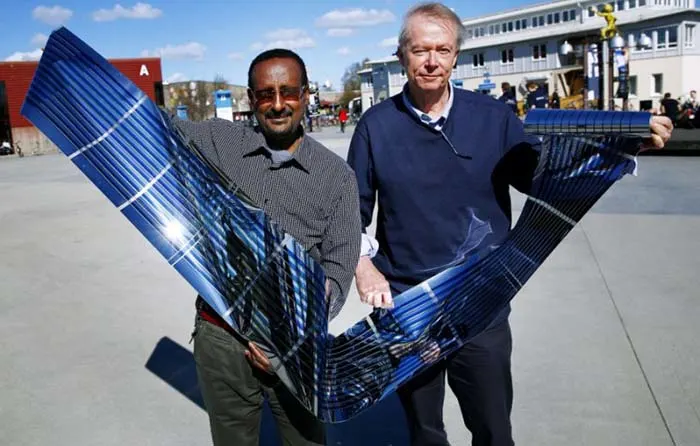Polymer solar cells are one huge step closer to becoming a commercially available option. They are cheaper to mass-produce and they can be produced in large rolls. This means that they are flexible, lighter than traditional silicone-based panels, and could potentially be applied in ways that wouldn’t be practical with traditional panels and they even offer the potential of being transparent, which would mean you could be producing solar power from your windows or really any surface without impacting the look or functionality.

Polymer solar cells manufactured using low-cost roll-to-roll printing technology, demonstrated here by professors Olle Inganäs (right) and Shimelis Admassie. Credit: Stefan Jerrevång/Linkoping university
Until recently the main issue was largely one of longevity. Earlier polymer panels used fullerenes which were more expensive and rather unstable in prolonged sun exposure and high temperatures. A new process has corrected those flaws. While typically less efficient than your more standard solar cells, their inexpensive, less toxic, and larger capacity production methods make them a pretty good option for a variety of applications, especially with this new process being about twice as efficient as a previous commercially available polymer cell.
“-We have demonstrated that it is possible to achieve a high efficiency without using fullerene, and that such solar cells are also highly stable to heat. Because solar cells are working under constant solar radiation, good thermal stability is very important, said Feng Gao, a physicist at the Department of Physics, Chemistry and Biology, Linköping University.
-The combination of high efficiency and good thermal stability suggest that polymer solar cells, which can be easily manufactured using low-cost roll-to-roll printing technology, now come a step closer to commercialization, said Feng Gao.” ~ ScienceDaily.com
Being a light and flexible material, the number of uses is about as diverse as your imagination allows. They would be a great additional option for those already living off-grid, but also could be very appealing to those who are considering it.
Cost is often a factor, and if this cheaper option becomes commercially available it can only benefit the off-grid community as a whole and allow those who were holding back because of the initial costs of getting set up.
Even if you were only to use them as a temporary fix or for additional solar power production at more demanding times of the year, they offer huge potential to anyone living off-grid.
***
